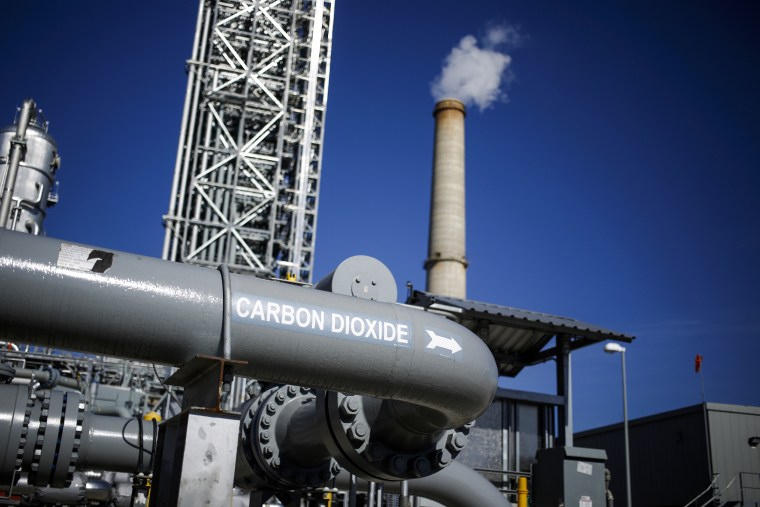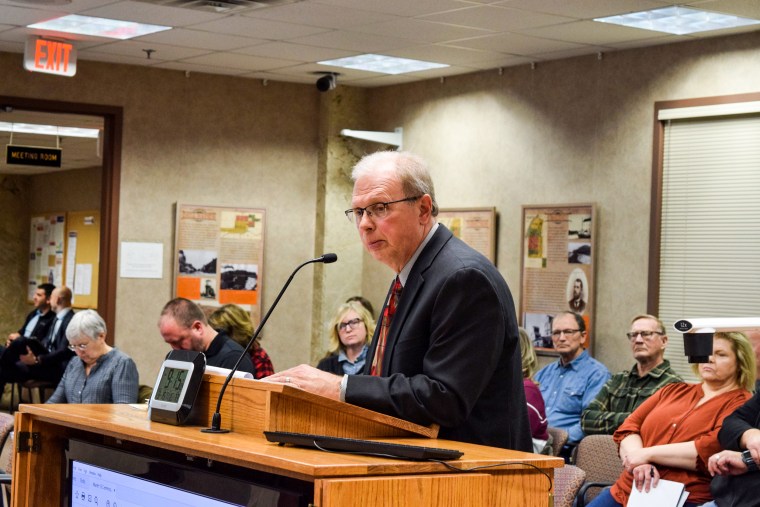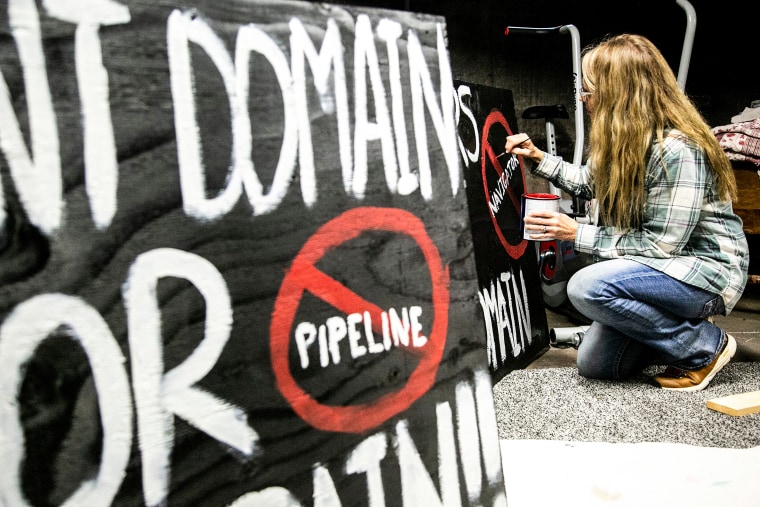Carbon capture projects have sprung up around the country as a way to curb greenhouse gases. Opponents say it’s a false solution and a waste of money.
In September, Bonnie Ewoldt and her husband received certified letters from a company called Summit Carbon Solutions telling them that their 170-acre soybeans-and-corn farm in Crawford County, Iowa, was in the path of a pipeline that would carry carbon dioxide from ethanol plants across the Midwest to an underground storage site in North Dakota.
They’d never heard of such a thing.
“We just thought it was ridiculous,” Ewoldt, 76, recalled.
A retired high school teacher and former local newspaper columnist, Ewoldt began researching the project online.
Summit had pitched the $4.5 billion pipeline several months earlier as “the world’s largest carbon capture and storage project,” saying it would help Iowa’s ethanol industry remain viable by lowering its carbon footprint as the country races to curb the effects of climate change. But first, Summit needed to bury the lines beneath thousands of parcels of privately owned property, mostly farmland.
Ewoldt worried about her farm being damaged, or losing its value. And she saw the project as a violation of the deep emotional connection farmers have to their land. She became an anti-pipeline activist, writing letters to Iowa newspapers and organizing an opposition group of fellow farm owners.
She is now among hundreds of holdouts who have formed an alliance with some environmentalists who say the pipeline project plan is unsafe, pointing to a 2020 leak at a carbon dioxide pipeline in Mississippi that sickened dozens of people. Summit says the pipeline will be safe during construction and once it starts carrying carbon dioxide, which will be in a purer form than the Mississippi pipeline.
The opponents also argue that the pipeline — one of dozens of carbon capture projects that have launched in recent years, backed by billions of dollars in federal subsidies — will do little to fight climate change.
Two more companies have announced plans to build similar pipelines in Iowa, making the state a focal point in an escalating battle over carbon capture, an old technology that has largely been used to squeeze more oil out of the ground but is now being promoted as an environmental cure.
The clash in Iowa has led to protests and tense public hearings, a pattern that has unfolded in states across the country amid a boom in carbon capture and storage. There are only 12 such projects operating commercially in the United States, but, fueled by a blast of federal subsidies, there are 85 in development, 51 of which were announced in 2021 alone, according to the Clean Air Task Force, a nonprofit that advocates for the expansion of carbon capture.
While carbon capture has not yet proven to be financially sustainable, and its environmental benefits are debatable, it is now seen by some as one of the last hopes to curb planet-warming emissions before the world passes a tipping point into unprecedented heat waves, droughts, fires, floods and extinctions of species.
President Joe Biden has made carbon capture and storage a cornerstone of his climate plan. Biden’s infrastructure law, enacted in November, includes more than $8 billion for carbon capture projects, and he has proposed more generous tax breaks for developers that have yet to be approved by Congress. That’s on top of more than $8 billion in direct funding and tax credits that the federal government has already given carbon capture projects since 2010 — despite the fact that government watchdogs have found a high failure rate and evidence of improperly claimed tax credits.

A variety of polluting industries — ethanol, natural gas, coal, chemicals — see carbon capture as a way to deliver on emission-reduction promises and compete in carbon-credit programs while keeping their existing operations productive. Increasing federal subsidies could lead to a reduction of up to 250 million metric tons of carbon dioxide emissions by 2035, the technology’s supporters say. That’s still a fraction of the more than 5 billion metric tons emitted by the United States in 2020.
Lee Beck, the Clean Air Task Force’s international director for carbon capture, said the Iowa projects “embody the next generation of carbon management projects” in which private companies and investors see a viable future for the technology.
“Climate regulation will come, and we want to be on a path to net zero emissions,” Beck said.
The rise of carbon capture has split environmentalists. Some say it’s worth trying anything to avert climate disaster. Others argue that carbon capture is a waste of money that may make things worse by extending the life of polluting industries.
“This is a scam that will squander our opportunity to respond to this crisis, and it needs to be stopped,” said Jim Walsh, policy director at Food & Water Watch, a nonprofit that advocates for an end to fossil fuel production and a turn to 100 percent renewable energy, including wind and solar.
The transformation of carbon capture from a tool for oil extraction to an answer to global warming reflects the tangled politics of climate change, in which the urgent need to cut greenhouse gasses has driven an all-of-the-above strategy and opened a spigot of government dollars, much of which benefits polluting industries.
“We do have to try anything,” said Gregory Nemet, who studies how public policy can spur climate-friendly technology at the University of Wisconsin-Madison. “If we want to deal with the climate problem and make it safe, we have to get to net zero emissions by 2050, and that’s not that far away.”

Iowa may now be the technology’s biggest test.
Of three pipelines proposed for the state, Summit Carbon Solutions’ project is the largest — and the one that has drawn the widest backlash. If it’s approved by state authorities, the project would be able to transport 12 million tons of carbon dioxide per year, far more than any pipeline currently operating.
The carbon dioxide would come from plants that produce ethanol, a fuel made from fermented corn. This process creates enormous quantities of carbon dioxide as a byproduct. Summit’s plan would capture the gas before it’s released and turn it into a liquid.
The liquified emissions would be shot through 2,000 miles of pipelines that would snake northward, gathering more carbon dioxide from more than 30 ethanol plants in five states before arriving at a storage site in Bismarck, North Dakota. The carbon dioxide would then be driven thousands of feet underground into massive, porous rock formations that would later be capped.
Nearly all of the carbon capture projects in operation in the United States use the carbon dioxide to draw more oil from underground, by injecting it into sludgy oil formations, where it lowers the oil’s viscosity and makes it easier to pump to the surface. This decades-old technique helps the projects make money, but also contributes to the burning of fossil fuels.
Summit says it will not do this in its North Dakota project, but instead will store the carbon dioxide underground. Environmentalists say they don’t trust Summit to keep that promise.
Summit says its plan would help ethanol plants, which are facing an uncertain future with the rise of electric cars, to stay in business by becoming purveyors of an increasingly valuable commodity: fuel with a lower carbon footprint, prized by California and other states with low-carbon fuel standards.
The project would extend plants’ “long-term profitability and viability, which is important to rural America given that half of its corn crop is turned into ethanol,” said Justin Kirchhoff, president of Summit Ag Investors, which, like Summit Carbon Solutions, is a division of the Iowa-based Summit Agricultural Group.
The company will also rely on federal tax credits, Kirchhoff said. Without the credits, the Summit pipeline “would not be financially feasible,” he said.

The project requires approval from the Iowa Utilities Board before construction can begin, a decision that isn’t expected to be made for months.
Summit also needs access to land owned by tens of thousands of people, mostly farm owners, to build the pipeline. Summit says the company has paid $20 million to landowners and secured permission for more than 100 miles of land in Iowa. But some landowners, concerned about the effect on their crop yields or angry about a company trying to push into their backyard, are refusing the company’s cash offerings for easements on their land. If Summit can’t win them over, the company could ask the utilities board to invoke the power of eminent domain to force deals.
That has angered landowners even more, and prompted an attempt in the state Legislature to ban the use of eminent domain for the pipelines. The bill, opposed by Summit and two other pipeline developers, failed. Landowners and their lawmaker allies are still trying.

Opponents have noted that Summit employs some of Iowa’s most influential political figures, including Terry Branstad, a former Republican governor who serves as a senior policy adviserfor Summit Carbon Solutions; Bruce Rastetter, a major Republican donor who runs the parent company, Summit Agricultural Group; and Jess Vilsack, who is Summit Carbon Solutions’ general counsel and the son of U.S. Agriculture Secretary Tom Vilsack.
“This is about the powerful versus the powerless,” said Jessica Mazour, who is organizing the opposition for the Sierra Club’s Iowa chapter.
Courtney Ryan, a Summit Carbon Solutions spokeswoman, said in an email that the company was “proud to have a bipartisan team working to advance this project and it’s a reflection of its importance to agriculture and ethanol in the Midwest.” She also said Summit was “following every federal and state guideline.”
Ewoldt wants them to fail.
She and her husband no longer work the family farm, which they bought 50 years ago, when they were in their 20s. They sold their house there, moved a couple hours north to Dickinson County, Iowa, and now rent the farm to a young man who works the land. Ewoldt wants corn to remain a lucrative crop. She wants to help the environment. But it’s not worth giving an easement to a corporation that will dig up her land for a pipeline, she said.
“It’s a value thing with farm people,” Ewoldt said. “The land is just part of you. We cherish our agricultural background. That’s who we are. It’s who I am.”
So she will refuse the pipeline maker’s offers. So will many others. But the pipeline may still get built.




